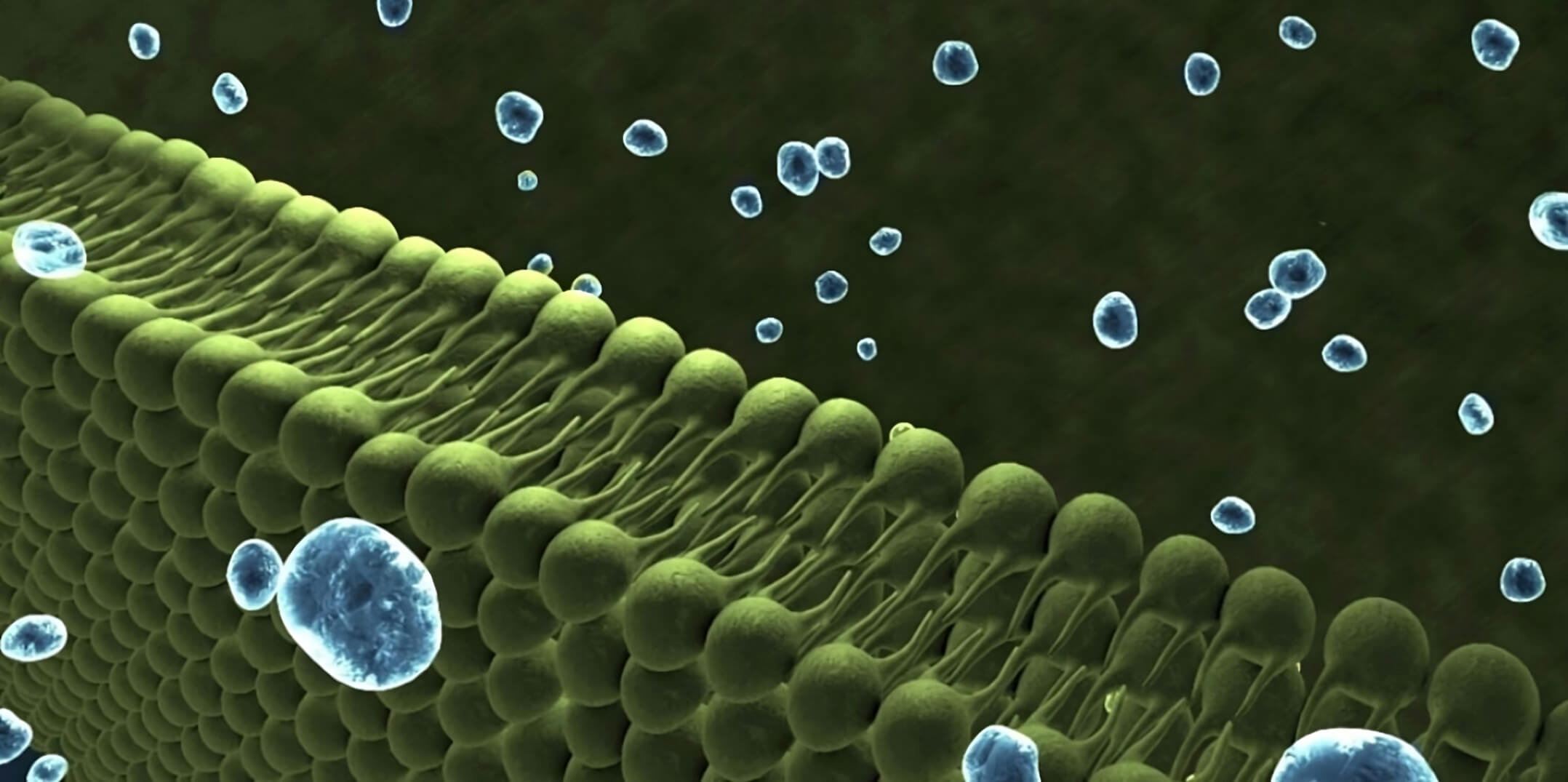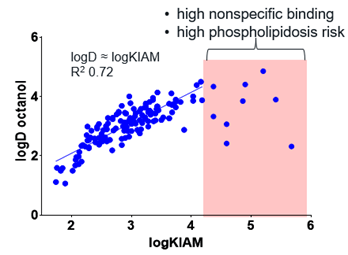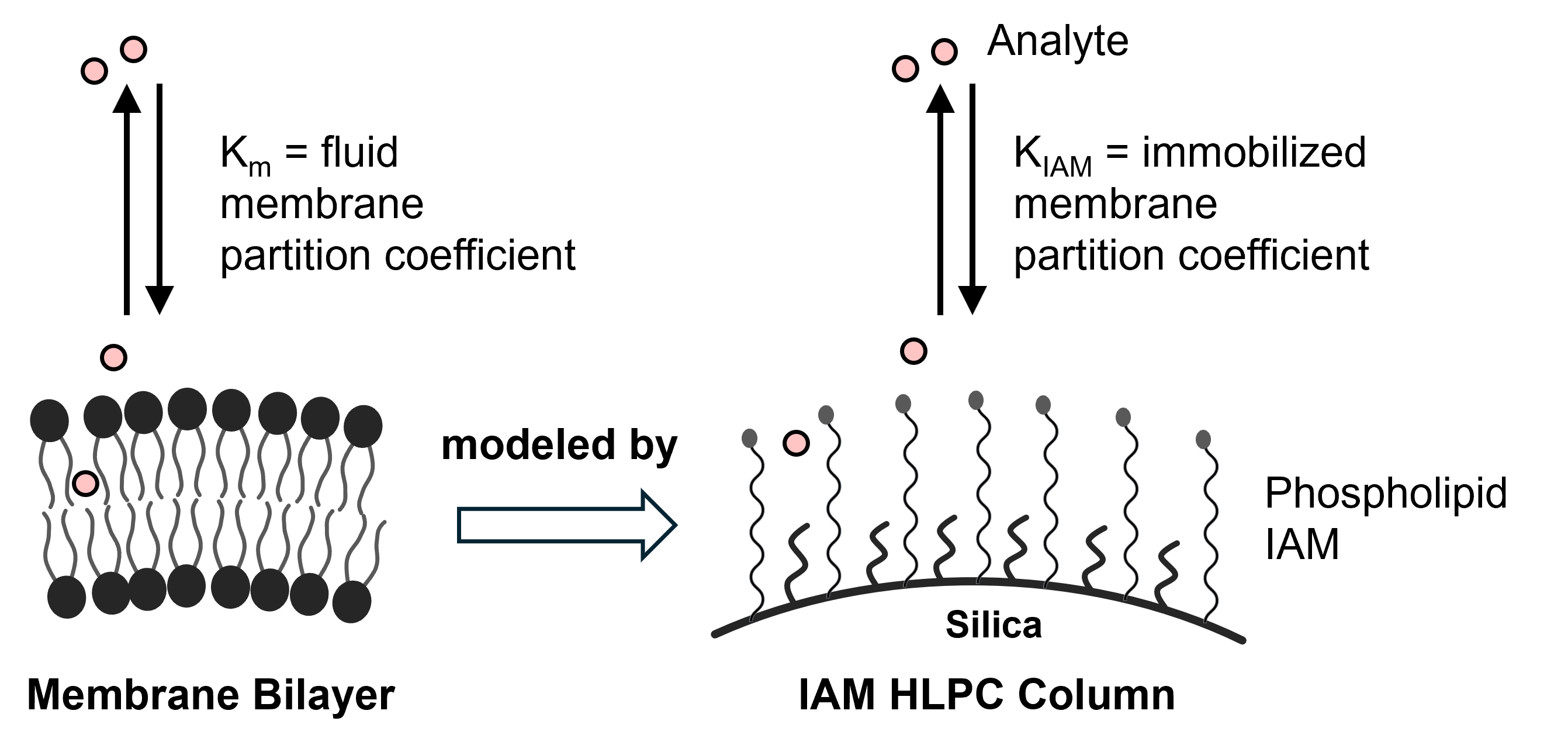Log KIAM Is the New LogD
By Johan Bartholomeus, Senior Principal Scientist, and Philippe McGee, Principal Scientist

In a drug discovery project, during the hit-to-lead and lead optimization phases, pharmacokinetic parameters (absorption, distribution, metabolism, excretion [ADME] and toxicity) become increasingly important because they can indicate which drug candidates have the greatest therapeutic potential with the lowest risks. A commonly overlooked technique called KIAM is of particular interest to X-Chem, as this technique can predict aspects of absorption, target promiscuity and certain types of toxicity — think a stitch in time saves nine (Fig. 1).

Log KIAM as a potential indicator for toxicity and membrane partitioning
Log KIAM refers to the partition coefficient (K) of a compound between an aqueous phase and an immobilized artificial membrane (IAM). This value can be used to predict a compound’s likelihood of passive diffusion and, hence, the compound’s potential for passage across biological membranes.
What KIAM can also indicate is the probability of a drug candidate to display off-target promiscuity or induce phospholipidosis, a condition where excess phospholipids and drugs accumulate inside lysosomes. Under normal conditions, lysosomal phospholipase A2 (LPLA2) is bound to the inner membrane of the lysosome through electrostatic charges. There, phospholipase digests phospholipids, which is a natural process of metabolism.
However, in situations where phospholipidosis is induced by a drug, the drug accumulates at the inner membrane of the lysosome. This eliminates the anionic binding sites for the phospholipase, resulting in its degradation and toxic accumulation of phospholipids. Compounds with log KIAM values > 4 can carry a phospholipidosis risk and should be considered carefully before progressing.
Although log KIAM is just one factor to consider when assessing the potential risk of target promiscuity or phospholipidosis associated with a compound, we at X-Chem think that it is good practice to deprioritize compounds with high log KIAM values to derisk downstream drug development efforts.
A simple implementation to obtain log KIAM through High Performance Liquid Chromatography (HPLC)
Log KIAM values can be obtained simply through HPLC (Fig. 2). The analyte is introduced in the chromatographic system where it interacts with the stationary phase — the phospholipid IAM and the mobile phase — the aqueous buffer. The retention time of the analyte is calibrated to a set of reference compounds to calculate the partition coefficient, which is then converted to log KIAM.

The log KIAM value can be considered a more biologically relevant variant of log D. We systematically measure log KIAM for all project compounds synthesized at X-Chem as a routine part of the QC process.
Moving compounds to development candidates with more confidence
In conjunction with other measured parameters, log KIAM values can help provide early-stage predictions of the properties and behavior of synthesized compounds in vivo.1 By studying the retention time, peak shape and elution profile of a drug on a biomimetic column, we can improve our ADME and toxicity predictions.2
For example, we observed a clear relationship between log KIAM and the fraction unbound in microsomes (Fig. 3). Since compound stability in microsomes can increase with increasing proportions bound to microsomal macromolecules (as such, protecting the drug from being metabolized), rank ordering compounds by their total clearances risks reflecting differences in microsomal binding rather than actual metabolic stability.

We believe that log KIAM will be a standard measurement in the future the way that logD is now. Our clients will benefit from getting KIAM values on all project compounds. Log KIAM data will allow us to advance projects more quickly, creating compounds with the right balance of properties to eventually become development candidates.
References
- Casartelli, A. et al. A cell-based approach for the early assessment of the phospholipidogenic potential in pharmaceutical research and drug development. Cell Biology and Toxicology, 2003, 19(3), 161-176.
- Valko, K.L. Application of biomimetic HPLC to estimate in vivo behavior of early drug discovery compounds. Future Drug Discovery, 2019, 1(1), FDD11.
- Armstrong, D. et al. Predictive Toxicology: Latest Scientific Developments and Their Application in Safety Assessment. In Comprehensive Medicinal Chemistry III. Elsevier, 2017, 94-115.
Flow Chemistry for Contemporary Isotope Labeling
Isotope-labeled compounds have emerged as important tools in drug discovery and development. The incorporated isotopes, particularly deuterium, in pharmaceuticals, have...
Driving Discovery Through Miniaturized High-Throughput Chemistry
When chemists approach the formation of a new bond, they often choose reaction conditions that they (or their colleagues) are...